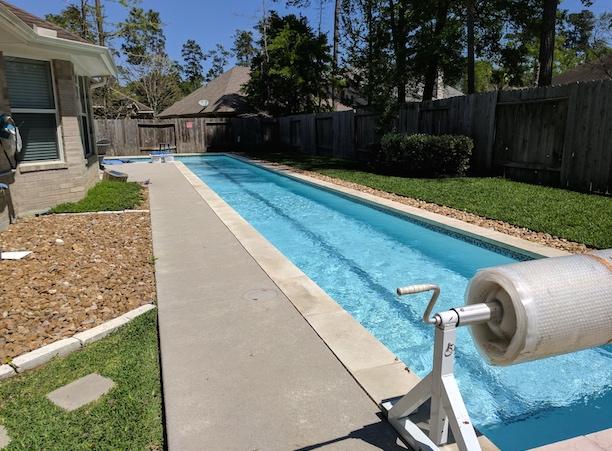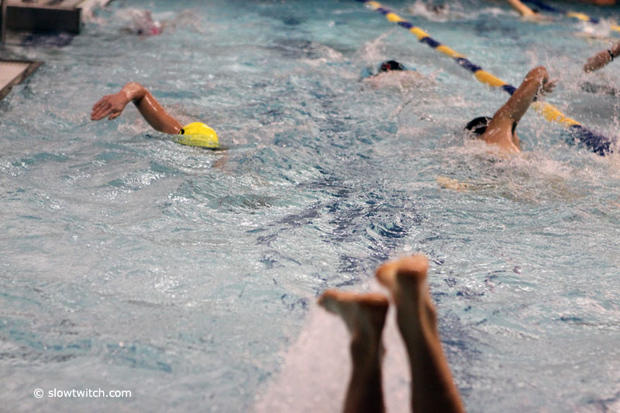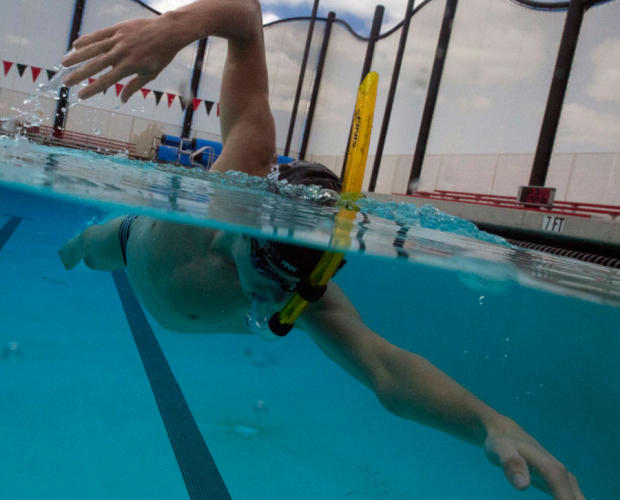Flip Turns
There's a poll ongoing right now on Slowtwitch. Half of you don't flip turn. All of you who don't flip turn would like to. Most of you acknowledge this.
Why don't you? (If you don't.) I suspect the reasons are three:
1. You think you'll look silly while you're learning.
2. You've tried, a few times, got dizzy, and gave up.
3. You think you'll hit your feet on the concrete edge of the pool.
When we're done here I think and hope that I can dispel these concerns and roadblocks. (Well, all except the looking silly part; just suck that up; nobody knew how to flip turn immediately.)
Why is it important that you, as a triathlete, learn how to flip-turn? First, open turns in a pool allow you rest once every length of the pool. I know you probably don’t think so, if you’re swimming open turns, nevertheless this is the case, and once you start flip turning you’ll agree.
Second, while I don’t think it’s of any benefit to you to deliberately eschew oxygen while you swim – I’m not a fan of hypoxic sets, or of breathing every third stroke – I do like the idea of having to go underwater every length, to get used to the fact that you will occasionally miss breaths while open water swimming.

Finally, I want you swimming with people as fast or faster than you in workouts. Not every workout. But a lot of workouts. You need to swim faster. You need to swim with fast people to swim faster. You need to swim with a better crowd. You need speed to swim with that crowd. And no, you do not open turn as fast as you will flip turn. Open turns are like race walking: why try to optimize an obviously slower technique?
So, how do you flip turn? The most obvious misconception about flip turns – and I don’t need to ask you to know this, I see this when I watch you try to flip turn – is that the flip, the rotation, is a discrete act in which you physically, muscularly, engage separate from the normal course of swimming. What I mean is, you swim to the end of the pool, you pretty much stop, and you try, muscularly, to spin, to turn a somersault. Of course, you get about halfway around that somersault and your spin runs out of gas.
In fact, the turn is not nearly so hard. Just as a world class high jumper is able to transform his running speed on the ground to height, you transform or translate your speed in the water into the energy that propels that somersault.
Here’s a video of Sun Yang and 7 of his closest friends in slow motion (I love this video, I play it to Gorecki’s Symphony #3).
Lots of flip turning going on in this video. It’s the speed into the wall – all the way into the wall – that energizes the flip. Note how the last thing these swimmers do is pull right into the flip, that is, one hand and then the other pulls right into the flip, to keep the speed up. The speed empowers the flip.
If you want to, further slow down the video with your Youtube settings. Once the video is playing you'll see icons, it's the one that looks like a gear on the bottom right of the video.
Me, I don’t bend at the waist when I begin my flip, I just sort of curl or peel my body from the head down. I begin by dropping my head, then hunching my shoulders, so that my body looks kind of like a question mark by the time I’m ready to fully flip. You begin by looking at your toes, but without bending at the waist or bending your knees. I think this makes my body kind of like a louvre, the water hitting my back and helping force that somersault.
If you're a newbie flip turner you’re probably (unfortunately) using your hands to scull, and give you extra energy, to complete the turn. Avoid that if you want to learn this skill properly. If you watch these guys flip, here’s what happens with their hands and arms. The last two strokes – left and then right, or right and then left, doesn’t matter – leave the swimmer with both arms straight back, like he’s standing at attention, hands at his side (just, standing at attention horizontally). The arms are now pointed back toward the other end of the pool. When these guys flip (watch them in the video), everything moves but the arms. The arms stay put, immobile in the water. They stay pointed at the other end of the pool. The end result of this is, now, flip completed, their hands are directly out in front of you, Superman-style.
Watch the video. Pulls completed, hands are at the swimmers’ sides going into the turn; hands are now straight in front of the swimmers’ heads coming out of the turn.
Another way to look at this: From the moment you enter the turn, hands at your sides, your hands do not change where they are, in the water, during the turn. They occupy the same space, the same place, in the water, during the turn. Imagine your hands are butterflies in God’s butterfly collection, and he’s just straight-pinned your hands in place. You have to execute the flip turn with your hands stuck right there, immovable. The benefit of this is, no extraneous movement, nothing slowing you down, and your hands and arms are perfectly positioned for your push off the wall.
Okay, but, what about your feet? Isn’t it going to hurt when I miscalculate and my heels come banging down on the pool deck instead of in the water? Yes, that would hurt. Why doesn’t that happen to me? I retract my feet just before they (would) hit the wall. I bend my knees. I pull my feet in. Does every swimmer do this? No. But look at that video again! These guys all pretty much do this. The old days of the legs hitting the water with a flourish, just to show what a cool flip turner you are, they're gone. Now it's retracted knees, no big splash. I also think bending the knees partway through the flip acts a little like figure skating spins, where pulling appendages (arms and legs) toward the centerline accelerates the spin.
By the time you get to the point where your retracted feet contact the water your turn is pretty well completed.
When you flip, and the flip is completed, are you now upside down in the water, looking through the water to the sky? Yes. No. Maybe. Depends on the swimmer. Sun Yang, yup, that’s how he turns. This means his push off the wall is executed with him ready to – seemingly – do the backstroke. He coils, like a corkscrew, in the water, executing that half turn that brings him now face down in the water, after his push off the wall.
But if you look at this video, not all swimmers execute that entire corkscrew from facing up to facing down after the turn. Some swimmers turn a bit lopsided, off to the side, so that by the time they’re ready to push off the wall they’re already partway rotated. That’s me. That’s now I flip turn. Good or bad? Don’t know.
Here's a how-to-flip-turn video that's pretty good. Notice again, knees are contracted well before the feet hit the water, so, no chance of the feet hitting the side of the pool.
In my opinion, the non-negotiable elements of the flip are: 1) that you don’t use arms and hands to propel the flip, they are passive actors; 2) the flip is not executed so far away from the wall, out of fear of contacting the wall with your heels, that you have to drift into the wall after the flip.
Do you see these people whose feet come slapping down on the water hard, about a mile-and-a-half from the edge of the pool? There’s no value in slapping your feet hard on the water. There’s no value in slapping them down with a straighter leg, to draw more attention to your sexy flip turn. The girls aren’t going to think, “Oh, what a sexy guy, look at how those feet just slap the water hard; he must be a real tiger.” The girls are going to think, “Man, that fool’s heels are really going to hurt someday when he jams the turn and misjudges the wall.” When you see these people turning far from the wall, drifting into the wall so that they can eventually push off, it’s because they did jam a turn once, it did hurt, and their incorrect, unfortunate take-away was to turn a long way away from the end of the pool. Better, in my opinion, to simply retract the feet a bit just before the turn is fully executed; and to not slap the feet down on the water as hard as you can.
The negotiable elements of the turn are how much you rotate your body around its longitudinal axis during the flip; and 2) whether you dolphin out of the turn on the way to the surface or not. These really good swimmers do one dolphin kick into the turn, and one or more out of it. How important is this? It's more important the better you get at it; and it's more important the more effective your dolphin kick (mine is especially ineffective).
Do not ignore the Ts and targets in the pool. That T at the end of the black line at the bottom of the pool, on each end, is to give you a sign or signal allowing you to know how to gauge your turn. When to begin your turn. That’s the entire and only point of the T. Likewise the target. That’s the + sign on the pool wall. These are visual devices telling you when to turn. Same thing, by the way, with those flaglines above the pool near each end. Those are backstroke flags, to tell backstrokers when to execute their turns. Use the Ts and targets to tell help you gauge your timing. It’s going to take a little practice but you’ll get it.




